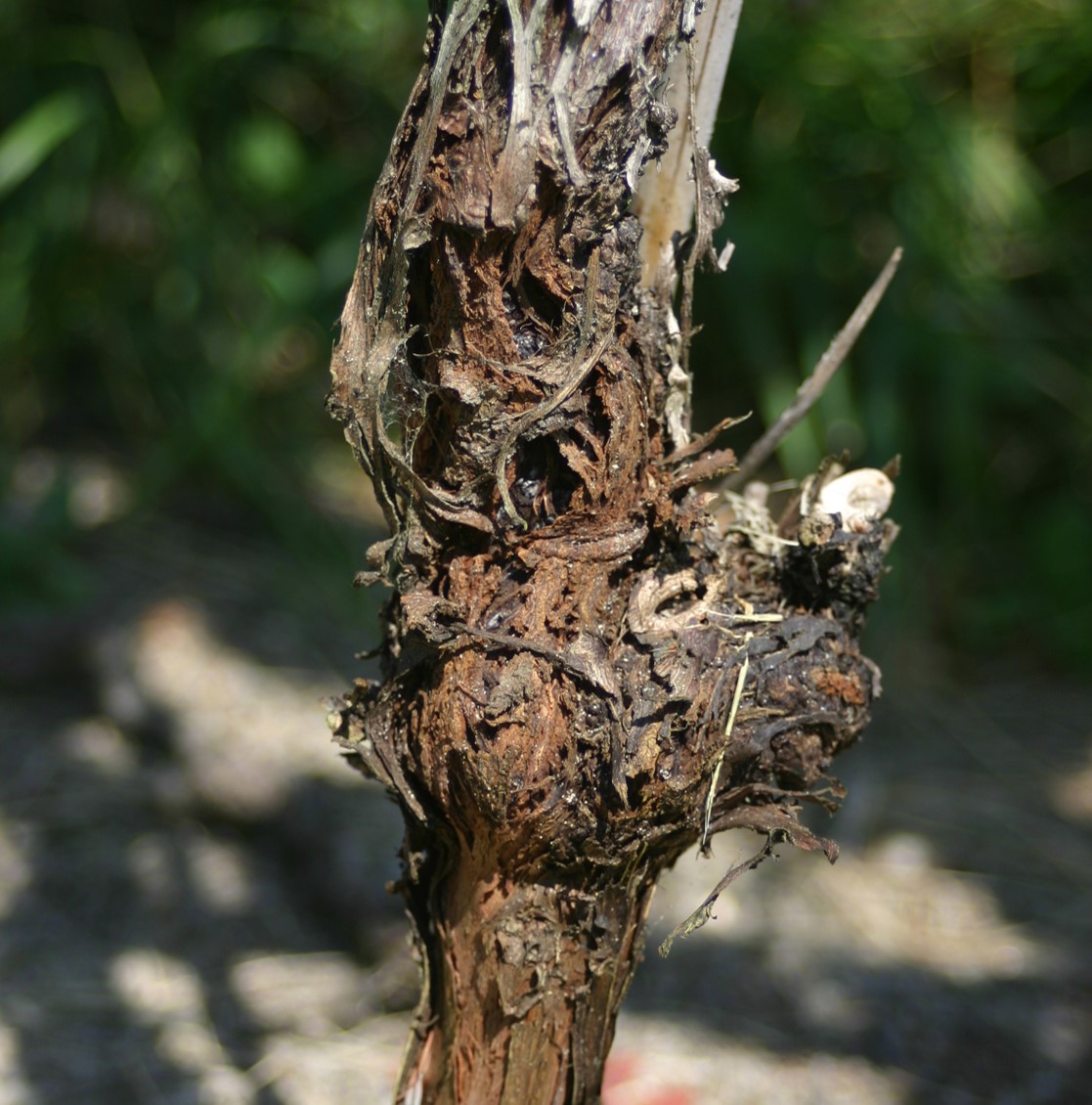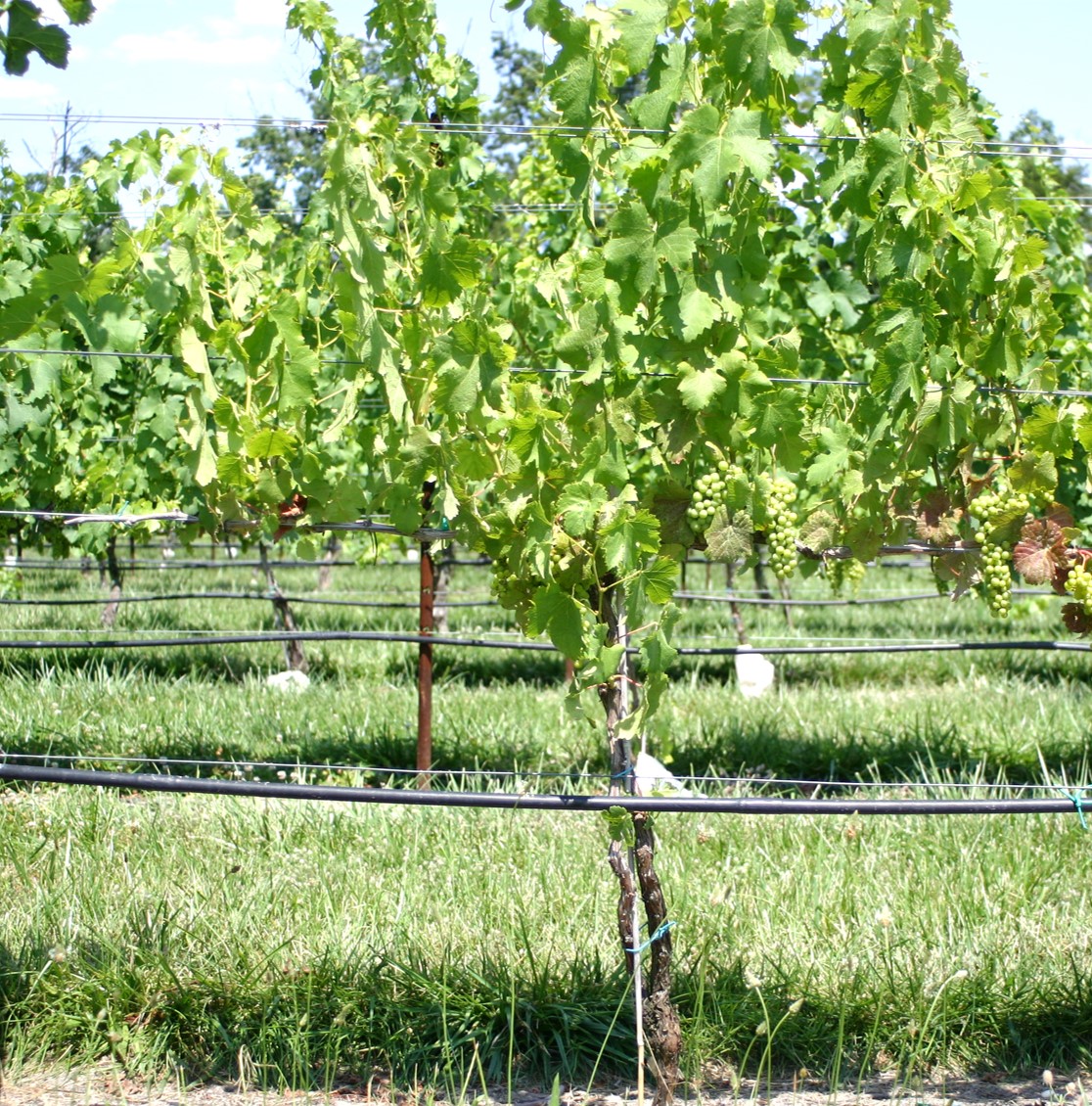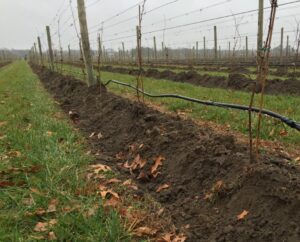What is Crown Gall?

Figure 1. Early symptoms. Young soft galls developing on the graft union during early spring (L) and cracking of bark by growing crown galls (C and R).
Crown gall is a serious disease affecting grapevines, particularly in cool-climate viticulture. It is caused by the soil- and plant-borne bacterium Agrobacterium vitis (A. vitis). This pathogen induces tumor-like growths (galls) that disrupt the grapevine’s vascular system, reducing the flow of water and nutrients from roots to shoots. If left unmanaged, crown gall can stunt vine growth and eventually kill the plant.
Diseases Symptoms
The earliest and most distinctive symptoms are abnormal, soft, whitish swellings (see Figure 1, Left). As these galls grow, they cause the bark to crack and peel due to pressure from underneath (Figure 1, Center and Right). Galls can initially be mistaken for benign growth, and therefore, detection requires careful inspection.
As the disease progresses, galls may become woody, rough, and brown, growing to several inches in diameter (Figure 2). They most often appear at the graft union or sites of mechanical injury on the lower trunk. The graft union is especially susceptible due to: (i) its irregular shape, which is prone to cracking, and (ii) potential contamination by A. vitis during the grafting process. Galls may also form on cordons and canes. Early scouting and removal of affected trunks can help limit the spread of infection. If the gall encircles the vine’s vascular system, the entire plant may collapse and especially in young vines, which have thinner trunks.
Another indicator of severe infection is the emergence of multiple new suckers from the vine base (Figure 1, Left). Additionally, leaves of affected vines may show green wilting and reddening due to restricted water and nutrient flow (Figure 3). However, similar symptoms can also result from viruses or nutrient deficiencies, making diagnosis challenging. In such cases, inspect the trunk visually for physical signs of gall formation or vascular disruption.
Why does wounding cause gall formation?
Wounding is a key point of infection in crown gall development. In early spring, grapevines attempt to heal sites of winter injury by producing callus tissue. These masses of undifferentiated cells with soft cell walls are particularly vulnerable to infection. A. vitis, which may already be present in the vine, exploits these wounds to inject its DNA into the callus cells. This bacterial DNA contains a tumor-inducing gene that integrates into the plant’s genome, leading to uncontrolled cell division, resulting in the characteristic gall.
Management of Crown Gall
An integrated pest management (IPM) approach is essential for effective crown gall control. Strategies include:
1, Avoidance
Site selection is the best decision to avoid cold injury. Avoid planting in low-lying areas where cold air settles. Gentle slopes are preferable for air drainage but beware that cold air may still collect at the lower end of a slope. Avoid planting in such spots unless you have excellent air drainage practices.

Figure 4. Grapevine in a year after hilling and damaging winter. Notice the graft union and trunk a few inches above it, unaffected by winter damage due to hilling-up, while the unprotected trunk shows crown gall.
2. Exclusion
Start with clean, certified planting material to reduce the chance of introducing A. vitis into your vineyard. Ideally, use 2010 Protocol-certified stock, which is propagated using advanced screening techniques to minimize bacterial contamination.
3. Resistance
Different grapevine species vary in susceptibility. Vitis vinifera cultivars are generally more susceptible. Hybrids and some vinifera varieties show moderate tolerance. Native species and certain hybrids tend to have better resistance. Consider planting more resistant varieties in areas prone to cold injury.
4. Protection
Hilling up soil around the base of vines during winter is highly effective. The soil acts as insulation, protecting the graft union and lower trunk. While this won’t shield unburied parts of the vine, it can preserve enough tissue to allow regrowth from protected suckers (Figure 4). Training these suckers as new trunks and using multiple trunks per vine can reduce the risk of total vine loss. For detailed guidance, refer to Rutgers NJAES Factsheet FS1264.
5. Eradication
Remove and destroy infected vine sections (Figure 5). This is the most effective post-infection strategy. Scout during early spring or winter pruning. Any removed vine parts should be taken out of the vineyard entirely. If removing an entire vine, extract it with the root system, as A. vitis can persist in root debris for years.
6. Chemical Control Options
A few commercial treatments are available, including:
- Galltrol-A (AgBioChem, Inc., Provo, UT)
- Gallex (AgBioChem, Inc., Provo, UT)
- Copper-based compounds
- Antibiotics
However, their effectiveness varies. Once the bacteria establish themselves systemically, eradication becomes extremely difficult. Always follow label instructions and integrate chemical treatments with cultural practices for best results.
References
Burr T. and Martinson T. 2015. Start Clean, Stay Clean Grape Crown Gall. National Clean Plant Network. Factsheet.
Moyer M. 2013. Grapevine Crown Gall. – Disease Management White Paper. Wine.wsu.edu/research-extension/
Gohil H., Nitzsche P., and Ward D. 2017. Hilling up to Prevent Winter Injuries in Vineyard. Rutgers NJAES Factsheet 1264. https://njaes.rutgers.edu/fs1264/
Todaro T. and Longstroth M. Managing Grapevine Crown Gall. Michigan State University Extension.



 The principle of Hilling-up – How the soil works, both as a thermal mass that holds the heat and an insulator that slows heat loss.
The principle of Hilling-up – How the soil works, both as a thermal mass that holds the heat and an insulator that slows heat loss.